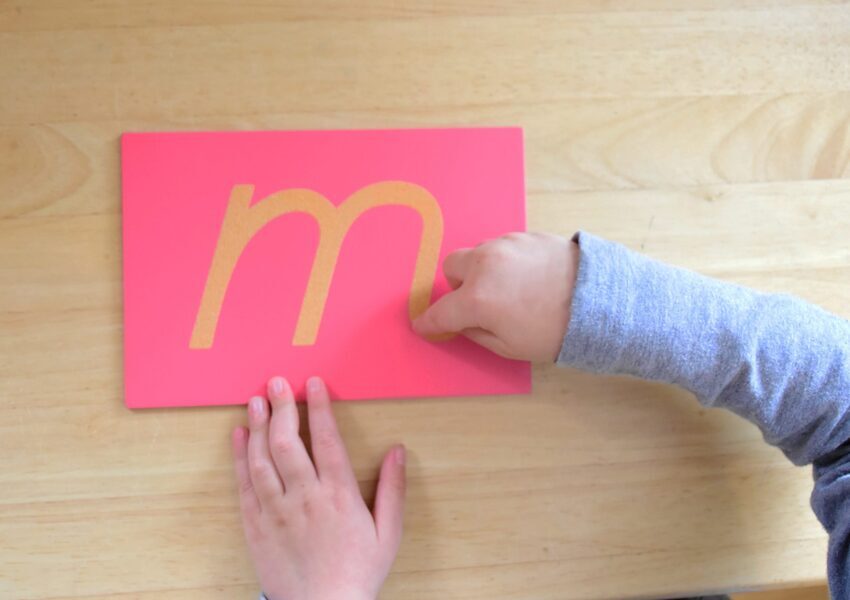
New Research Proves What Montessorians Have Long Known: Finger-Tracing Helps Children Learn
For more than 100 years, finger-tracing has been used by Montessorians to help children learn geometry and language. Ask a Montessorian about finger-tracing, and they might even quote Dr. Maria Montessori, who wrote in her seminal book, The Absorbent Mind: “He does it with his hands, by experience, first in play and then through work. The hands are the instruments of man’s intelligence.”
Now, new research is confirming what Montessorians have long known about how movement and touch can aid in learning.
Tracing to Success
Two recent studies from the University of Sydney compared groups of children who used finger-tracing to learn a lesson with those who did not, and the results showed the finger-tracing groups came out ahead.
In one study, conducted in Shanghai, China, nine and 10-year-old students were given a puzzle and instructed to find the missing angle. The control group was not allowed to touch the puzzle, while one group traced the shapes with their fingers and a third group traced the shapes before closing their eyes and imagining the tracing.
After the puzzle portion of the study, the children answered a questionnaire that measured learning motivation and cognitive load, or the amount of energy one spends during a mental activity.
A meta-analysis of the results showed that children who traced not only solved the puzzle more quickly, but had an easier time doing so as they had more motivation and less cognitive load.
Finger-tracing isn’t only effective for children, according to the second study. That study included 44 adults selected for their lack of astronomical knowledge. The astronomy novices were then divided into two groups: One learned about the lifecycle of a star with just text and a diagram, whereas the other group received the same text and diagram, but was told to use their hands to trace over the visual component.
The results were similar to the children’s study: The adults who traced had higher motivation and lower cognitive load.
“There are multiple reasons why tracing can help learning,” said Paul Ginns, the Associate Professor in Educational Psychology at the University of Sydney and co-author of both studies. “It seems that humans are biologically wired so that we pay closer attention to the space near our hands. So, when using an index finger to trace visual stimuli, these elements of a lesson receive processing priority. Tracing can also assist learning because it ‘chunks’ all the important elements of new material into one piece of information, making it easier for us to learn.”
Montessori Tracing
At the Montessori campuses in the Endeavor Schools family, finger-tracing is a common technique.
Faith Money, the school leader at Atlanta Montessori International School-Druid Hills, says finger-tracing is an important part of her Primary Program (3 – 6-year-olds).
“The goal is to give the child concrete materials to represent concepts that can be very abstract,” Money says. “When we see the children using their hands to understand concepts like alphabet symbols, length, weight, temperature, shapes, numbers, etc., we find they have a deeper understanding of these concepts and a solid foundation when moving to abstraction.”
One common finger-tracing technique is with the use of sandpaper.
“The sandpaper letters are a wonderful example of finger tracing,” Money says. “Once the child understands the concept of cat begins with the ‘c’ sound, we introduce them to the correlating symbol in cursive. Each letter is on a board and the letter symbol is made of rough sandpaper. Next, the child sensitizes their index and middle fingers by placing them in warm water and wiping them dry with a cloth. We then show the child how to correctly trace the letter a few times and they repeat tracing after them at least three times, but often we find the child enjoys it so much they will trace the letter many more times! While they are tracing this symbol the guide will say the sound it makes so the child is hearing the sound and feeling its symbol.”
Lee Lanou, the Director of Montessori Education at Endeavor Schools, said that new research, such as the University of Sydney studies, has added to the pile of evidence in favor of many Montessori techniques, such as the importance of combining hand movement with learning.
“More than 100 years after Dr. Maria Montessori invented her method, neuroscience research is flooded with evidence of the strong connection between the hands and the brain,” Lanou says. “In Montessori classrooms, children are given multi-sensory materials to guide their learning. This is combined with the freedom to repeat these movements as often as they desire, which creates an optimal and natural development for learning in young children.”
